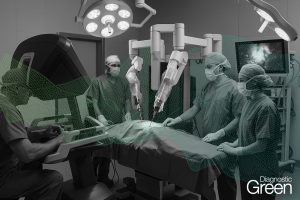Indocyanine green (ICG) fluorescence is useful in laparoscopic hepatectomy (LH) for tumor identification and staining, as well as determination of resection margins. At our Institution, patient-specific, three-dimensional simulations and rehearsal of surgical strategies are carried out preoperatively. We describe cases in which ICG administered preoperatively became stagnated and fluoresced in an area similar to the preoperatively established resection area and the pathological findings in these cases.
Results: In four cases, the areas of ICG fluorescence seen intraoperatively were due to stasis of preoperatively administered ICG, which fortuitously was equivalent to the planned resection area in the preoperative patient-specific simulation. The fluorescent areas were resected; there were no cases of bile leakage or recurrence. Fluorescence microscopy revealed areas with diffuse ICG fluorescence in normal hepatocytes on the tumor’s peripheral side.
Conclusion: It was suggested that resection of the liver area that was fluorescent due to stagnation of preoperatively administered ICG was rational and justified both anatomically and oncologically. This resection may also contribute to the prevention of bile leakage and recurrence.




